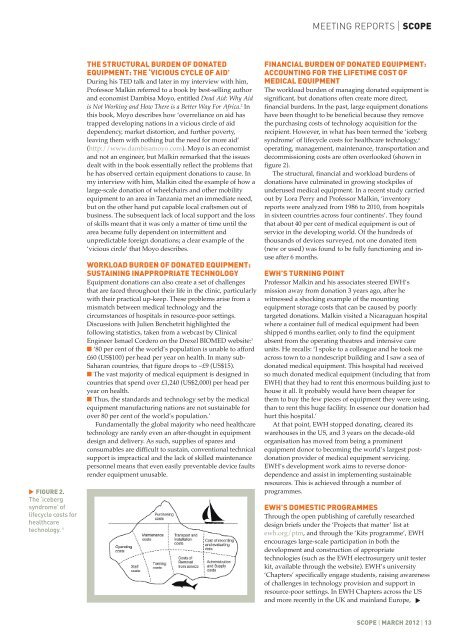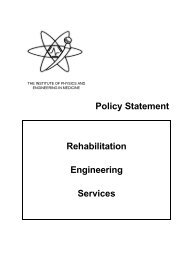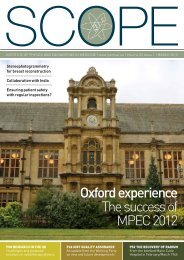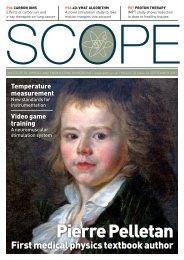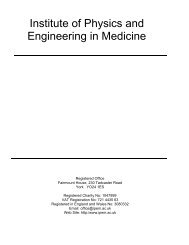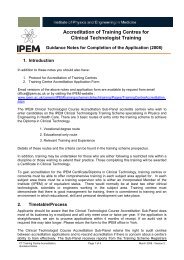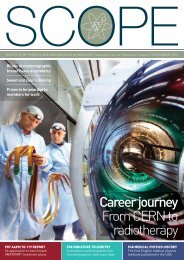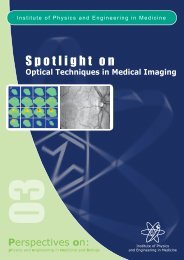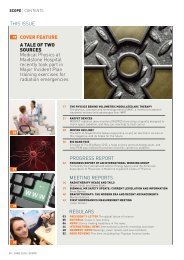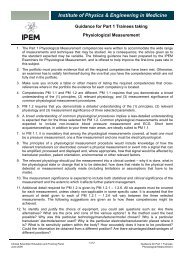March 2012 - Institute of Physics and Engineering in Medicine
March 2012 - Institute of Physics and Engineering in Medicine
March 2012 - Institute of Physics and Engineering in Medicine
Create successful ePaper yourself
Turn your PDF publications into a flip-book with our unique Google optimized e-Paper software.
MEETING REPORTS | SCOPE<br />
FIGURE 2.<br />
The ‘iceberg<br />
syndrome’ <strong>of</strong><br />
lifecycle costs for<br />
healthcare<br />
technology. 4<br />
▼<br />
THE STRUCTURAL BURDEN OF DONATED<br />
EQUIPMENT: THE ‘VICIOUS CYCLE OF AID’<br />
Dur<strong>in</strong>g his TED talk <strong>and</strong> later <strong>in</strong> my <strong>in</strong>terview with him,<br />
Pr<strong>of</strong>essor Malk<strong>in</strong> referred to a book by best-sell<strong>in</strong>g author<br />
<strong>and</strong> economist Dambisa Moyo, entitled Dead Aid: Why Aid<br />
is Not Work<strong>in</strong>g <strong>and</strong> How There is a Better Way For Africa. 2 In<br />
this book, Moyo describes how ‘overreliance on aid has<br />
trapped develop<strong>in</strong>g nations <strong>in</strong> a vicious circle <strong>of</strong> aid<br />
dependency, market distortion, <strong>and</strong> further poverty,<br />
leav<strong>in</strong>g them with noth<strong>in</strong>g but the need for more aid’<br />
(http://www.dambisamoyo.com). Moyo is an economist<br />
<strong>and</strong> not an eng<strong>in</strong>eer, but Malk<strong>in</strong> remarked that the issues<br />
dealt with <strong>in</strong> the book essentially reflect the problems that<br />
he has observed certa<strong>in</strong> equipment donations to cause. In<br />
my <strong>in</strong>terview with him, Malk<strong>in</strong> cited the example <strong>of</strong> how a<br />
large-scale donation <strong>of</strong> wheelchairs <strong>and</strong> other mobility<br />
equipment to an area <strong>in</strong> Tanzania met an immediate need,<br />
but on the other h<strong>and</strong> put capable local craftsmen out <strong>of</strong><br />
bus<strong>in</strong>ess. The subsequent lack <strong>of</strong> local support <strong>and</strong> the loss<br />
<strong>of</strong> skills meant that it was only a matter <strong>of</strong> time until the<br />
area became fully dependent on <strong>in</strong>termittent <strong>and</strong><br />
unpredictable foreign donations; a clear example <strong>of</strong> the<br />
‘vicious circle’ that Moyo describes.<br />
WORKLOAD BURDEN OF DONATED EQUIPMENT:<br />
SUSTAINING INAPPROPRIATE TECHNOLOGY<br />
Equipment donations can also create a set <strong>of</strong> challenges<br />
that are faced throughout their life <strong>in</strong> the cl<strong>in</strong>ic, particularly<br />
with their practical up-keep. These problems arise from a<br />
mismatch between medical technology <strong>and</strong> the<br />
circumstances <strong>of</strong> hospitals <strong>in</strong> resource-poor sett<strong>in</strong>gs.<br />
Discussions with Julien Benchetrit highlighted the<br />
follow<strong>in</strong>g statistics, taken from a webcast by Cl<strong>in</strong>ical<br />
Eng<strong>in</strong>eer Ismael Cordero on the Drexel BIOMED website: 3<br />
n ‘80 per cent <strong>of</strong> the world’s population is unable to afford<br />
£60 (US$100) per head per year on health. In many sub-<br />
Saharan countries, that figure drops to ~£9 (US$15).<br />
n The vast majority <strong>of</strong> medical equipment is designed <strong>in</strong><br />
countries that spend over £1,240 (US$2,000) per head per<br />
year on health.<br />
n Thus, the st<strong>and</strong>ards <strong>and</strong> technology set by the medical<br />
equipment manufactur<strong>in</strong>g nations are not susta<strong>in</strong>able for<br />
over 80 per cent <strong>of</strong> the world’s population.’<br />
Fundamentally the global majority who need healthcare<br />
technology are rarely even an after-thought <strong>in</strong> equipment<br />
design <strong>and</strong> delivery. As such, supplies <strong>of</strong> spares <strong>and</strong><br />
consumables are difficult to susta<strong>in</strong>, conventional technical<br />
support is impractical <strong>and</strong> the lack <strong>of</strong> skilled ma<strong>in</strong>tenance<br />
personnel means that even easily preventable device faults<br />
render equipment unusable.<br />
FINANCIAL BURDEN OF DONATED EQUIPMENT:<br />
ACCOUNTING FOR THE LIFETIME COST OF<br />
MEDICAL EQUIPMENT<br />
The workload burden <strong>of</strong> manag<strong>in</strong>g donated equipment is<br />
significant, but donations <strong>of</strong>ten create more direct,<br />
f<strong>in</strong>ancial burdens. In the past, large equipment donations<br />
have been thought to be beneficial because they remove<br />
the purchas<strong>in</strong>g costs <strong>of</strong> technology acquisition for the<br />
recipient. However, <strong>in</strong> what has been termed the ‘iceberg<br />
syndrome’ <strong>of</strong> lifecycle costs for healthcare technology, 4<br />
operat<strong>in</strong>g, management, ma<strong>in</strong>tenance, transportation <strong>and</strong><br />
decommission<strong>in</strong>g costs are <strong>of</strong>ten overlooked (shown <strong>in</strong><br />
figure 2).<br />
The structural, f<strong>in</strong>ancial <strong>and</strong> workload burdens <strong>of</strong><br />
donations have culm<strong>in</strong>ated <strong>in</strong> grow<strong>in</strong>g stockpiles <strong>of</strong><br />
underused medical equipment. In a recent study carried<br />
out by Lora Perry <strong>and</strong> Pr<strong>of</strong>essor Malk<strong>in</strong>, ‘<strong>in</strong>ventory<br />
reports were analyzed from 1986 to 2010, from hospitals<br />
<strong>in</strong> sixteen countries across four cont<strong>in</strong>ents’. They found<br />
that about 40 per cent <strong>of</strong> medical equipment is out <strong>of</strong><br />
service <strong>in</strong> the develop<strong>in</strong>g world. Of the hundreds <strong>of</strong><br />
thous<strong>and</strong>s <strong>of</strong> devices surveyed, not one donated item<br />
(new or used) was found to be fully function<strong>in</strong>g <strong>and</strong> <strong>in</strong>use<br />
after 6 months.<br />
EWH’S TURNING POINT<br />
Pr<strong>of</strong>essor Malk<strong>in</strong> <strong>and</strong> his associates steered EWH’s<br />
mission away from donation 3 years ago, after he<br />
witnessed a shock<strong>in</strong>g example <strong>of</strong> the mount<strong>in</strong>g<br />
equipment storage costs that can be caused by poorly<br />
targeted donations. Malk<strong>in</strong> visited a Nicaraguan hospital<br />
where a conta<strong>in</strong>er full <strong>of</strong> medical equipment had been<br />
shipped 6 months earlier, only to f<strong>in</strong>d the equipment<br />
absent from the operat<strong>in</strong>g theatres <strong>and</strong> <strong>in</strong>tensive care<br />
units. He recalls: ‘I spoke to a colleague <strong>and</strong> he took me<br />
across town to a nondescript build<strong>in</strong>g <strong>and</strong> I saw a sea <strong>of</strong><br />
donated medical equipment. This hospital had received<br />
so much donated medical equipment (<strong>in</strong>clud<strong>in</strong>g that from<br />
EWH) that they had to rent this enormous build<strong>in</strong>g just to<br />
house it all. It probably would have been cheaper for<br />
them to buy the few pieces <strong>of</strong> equipment they were us<strong>in</strong>g,<br />
than to rent this huge facility. In essence our donation had<br />
hurt this hospital.’<br />
At that po<strong>in</strong>t, EWH stopped donat<strong>in</strong>g, cleared its<br />
warehouses <strong>in</strong> the US, <strong>and</strong> 3 years on the decade-old<br />
organisation has moved from be<strong>in</strong>g a prom<strong>in</strong>ent<br />
equipment donor to becom<strong>in</strong>g the world’s largest postdonation<br />
provider <strong>of</strong> medical equipment servic<strong>in</strong>g.<br />
EWH’s development work aims to reverse donordependence<br />
<strong>and</strong> assist <strong>in</strong> implement<strong>in</strong>g susta<strong>in</strong>able<br />
resources. This is achieved through a number <strong>of</strong><br />
programmes.<br />
EWH’S DOMESTIC PROGRAMMES<br />
Through the open publish<strong>in</strong>g <strong>of</strong> carefully researched<br />
design briefs under the ‘Projects that matter’ list at<br />
ewh.org/ptm, <strong>and</strong> through the ‘Kits programme’, EWH<br />
encourages large-scale participation <strong>in</strong> both the<br />
development <strong>and</strong> construction <strong>of</strong> appropriate<br />
technologies (such as the EWH electrosurgery unit tester<br />
kit, available through the website). EWH’s university<br />
‘Chapters’ specifically engage students, rais<strong>in</strong>g awareness<br />
<strong>of</strong> challenges <strong>in</strong> technology provision <strong>and</strong> support <strong>in</strong><br />
resource-poor sett<strong>in</strong>gs. In EWH Chapters across the US<br />
<strong>and</strong> more recently <strong>in</strong> the UK <strong>and</strong> ma<strong>in</strong>l<strong>and</strong> Europe,<br />
▼<br />
SCOPE | MARCH <strong>2012</strong> | 13


